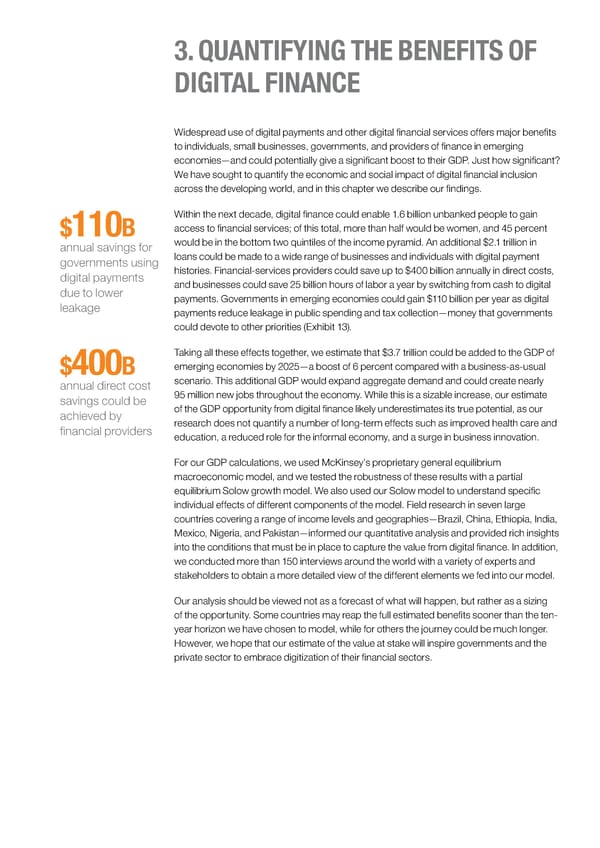3. QUANTIFYING THE BENEFITS OF DIGITAL FINANCE Widespread use of digital payments and other digital financial services offers major benefits to individuals, small businesses, governments, and providers of finance in emerging economies—and could potentially give a significant boost to their GDP. Just how significant? We have sought to quantify the economic and social impact of digital financial inclusion across the developing world, and in this chapter we describe our findings. Within the next decade, digital finance could enable 1.6 billion unbanked people to gain $110B access to financial services; of this total, more than half would be women, and 45 percent annual savings for would be in the bottom two quintiles of the income pyramid. An additional $2.1 trillion in governments using loans could be made to a wide range of businesses and individuals with digital payment digital payments histories. Financial-services providers could save up to $400 billion annually in direct costs, due to lower and businesses could save 25 billion hours of labor a year by switching from cash to digital leakage payments. Governments in emerging economies could gain $110 billion per year as digital payments reduce leakage in public spending and tax collection—money that governments could devote to other priorities (Exhibit 13). Taking all these effects together, we estimate that $3.7 trillion could be added to the GDP of $400B emerging economies by 2025—a boost of 6 percent compared with a business-as-usual annual direct cost scenario. This additional GDP would expand aggregate demand and could create nearly savings could be 95 million new jobs throughout the economy. While this is a sizable increase, our estimate achieved by of the GDP opportunity from digital finance likely underestimates its true potential, as our financial providers research does not quantify a number of long-term effects such as improved health care and education, a reduced role for the informal economy, and a surge in business innovation. For our GDP calculations, we used McKinsey’s proprietary general equilibrium macroeconomic model, and we tested the robustness of these results with a partial equilibrium Solow growth model. We also used our Solow model to understand specific individual effects of different components of the model. Field research in seven large countries covering a range of income levels and geographies—Brazil, China, Ethiopia, India, Mexico, Nigeria, and Pakistan—informed our quantitative analysis and provided rich insights into the conditions that must be in place to capture the value from digital finance. In addition, we conducted more than 150 interviews around the world with a variety of experts and stakeholders to obtain a more detailed view of the different elements we fed into our model. Our analysis should be viewed not as a forecast of what will happen, but rather as a sizing of the opportunity. Some countries may reap the full estimated benefits sooner than the ten- year horizon we have chosen to model, while for others the journey could be much longer. However, we hope that our estimate of the value at stake will inspire governments and the private sector to embrace digitization of their financial sectors.
 DIGITAL FINANCE FOR ALL Page 56 Page 58
DIGITAL FINANCE FOR ALL Page 56 Page 58